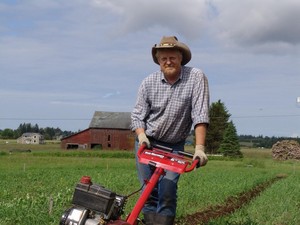10 Jul Fri 2009
Field Day Notes
Yesterday, I took the afternoon off and went down to a field day at the Mount Vernon Experimental Station. I learned quite a bit about seed growing and diseases in potatoes and spinach. For example, high tunnels help control late blight in both tomatoes and potatoes, which is bloody obvious, since the spores spread rapidly through splashing of rain drops or impact sprinkler irrigation. At the station, they had both potatoes and tomatoes together in a high tunnel. Per companion planting concepts, potatoes and tomatoes supposedly dislike each other, but I didn't get a chance to ask about that. Both species seemed to be doing all right together. I also learned about a new late blight-resistant variety called Defender. Per my web research, this is a white-skinned processing potato, developed in Idaho, that is usually used for french fries.
Another interesting point was how extra liming helps combat verticilium wilt in spinach. Preliminary findings are that lime is effective up to 2 tons per acre because it reduces pH. This is also the level where it starts to be uneconomical for most growers to put on more lime. Of course, we are talking about commodity farmers who are getting such a low return per acre (<$1000 or even <$500) that an extra ton of lime, at $65 per ton, is significant. If an organic grower sells through direct marketing and is getting $20,000 per acre for specialty crops, for example, an extra $65 per acre is insignificant. It is even insignificant if the direct marketer buys his lime in bulk or in bags. An interesting side note about pH is that anhydrous ammonia is acidic and so lowers pH when it is used as the nitrogen source in mainstream crop production. Switching to a higher-price nitrate source does not lower pH as much, and organic sources of nitrogen have even less downward pressure on pH.
The wheat trials were quite impressive. Washington State University (WSU)has been a leader in wheat trials for years and are developing perennial wheats, among other things. This is a slow process however, and will probaby take another 10-20 years. At the station, the USDA had a couple of plots of winter and spring wheats and were looking for resistance to stripe rust (reduces photosynthesis and thus reduces yield). The spring wheat plot had 9,000 varieties and the winter wheat plot had 8,000 varieties. These were all in 1x2 foot rectangles.
The station has 5 acres of certified organic trials and are doing some valuable work in things like wheat and pea cover crops for weed suppression in growing wine grapes. Washington has a significant wine industry now and I even prefer Washington over California wines. Hard cider is getting established in the state and there are also some trials with bittersharp apples for cider. I make hard cider with some of our apples like Kingston Black and I am pleased that there are local hard cider companies with products in the pipeline.
Finally, there are barley trials at the station and I learned a little about malting barley. One farmer at the field day mentioned low protein barley gives a clearer beer and the higher protein malts are the reason for the cloudiness of so many of the Northwest's craft beers. Well, I just had to confirm this, so I stopped at the Stein in Ferndale for a pint and asked Lloyd, the owner and head brewer. He confirmed what I had been told.
The bottom line is that experimental stations have a role to play, but they still put most of their energy into research for the chemical companies. There is a certain amount of buzz generated by the internet and in academia that land grant colleges are becoming irrelevant for agriculture research because of this. One of the ways the WSU Mount Vernon experimental station is keeping its relevancy is to devote some acreage to organic research. The five acres is just a small percentage of the total, but it is doing important work. The people at the Mount Vernon station also seem to value farmer input. I liken this to the archaeologist who does fieldwork, but still teaches introductory anthropology courses. Explaining the research and the discipline to novices helps the researcher to articulate his/her findings and provides important feedback from a perspective distant from day-to-day academia or fieldwork. Most of the advances in agriculture have probably come from the small farmer over the last 10,000 years and the ideological ground has shifted again. People like myself can do subjective trials on a small scale and both provide some subjective input to the station researchers, as well as get valuable objective info from them.

